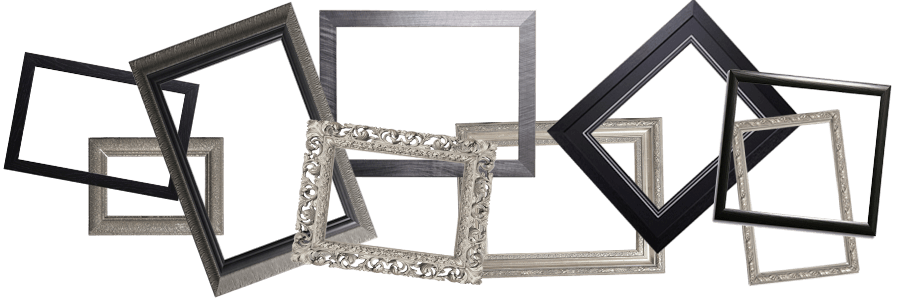FRAMING SPECIFICS
Frames vary enormously and there are many different ways to frame the same item. The right choices will enhance and protect the artwork and provide years of visual pleasure in your home.
This is the board that surrounds the artwork from its edge to the inner edge of the frame. Matboard is not essential for every item but can significantly compliment your artwork through its colour, texture, size and depth. It also protects the artwork from condensation by preventing it from touching the glazing. Angas Framing & Design use mainly conservation grade matboards both under and above your artwork. These are not only acid-free but have also had the wood pulp (lignin) removed which further prevents acid from developing. Acid is extremely harmful to artworks and can cause long-term damage.
Securing your artwork. We use and recommend reversible mounting methods for most artworks. This includes hinging with conservation grade materials and can be undone if the item ever needs re-mounting/framing. We hope you never drop your item but should this occur, the hinging will tear before the artwork does, thus limiting any further damage to your piece.
The protection offered by glazing is essential for all artwork on paper. We use and recommended Conservation Clear 99% UV protective glass which offers the best protection against fading and discolouration for your artwork. We also offer a less expensive alternative, Premium Clear with 45% protection, non-reflective glass with the same UV protection options and high quality acrylics which are extremely shatter-proof and great for over-sized items.
Angas Framing & Design offer a great range of frames sourced from Australian and overseas manufacturers. Each one is hand crafted and we do not use any synthetic mouldings. A wide range of blacks, whites, golds, silvers, colourful and natural timbers are available to choose from with a variety of styles including contemporary, decorative, traditional and rustic to suit your artwork, taste, budget and décor.
These protect the artwork from behind and support the framing package. We use acid-free or rag foam-boards or stiff conservation board behind the mounted and/or matted artwork. We do not use Masonite and rarely MDF as these products are highly acidic and add unnecessary weight.
Each frame is sealed with the backing board and tape to protect the contents from dust, insects and temperature fluctuations where possible. Felt ‘bumpers’ are also placed on the bottom corners of the frame to protect your wall and allow air and condensation to circulate behind the back of the frame.
We use quality plastic-coated hanging wire and if your piece requires special consideration for hanging, we will discuss this with you.
Matboard
– has the bevel (edge of window) discoloured or the matboard left any foxing marks on the artwork?
Frame
– is it timber or synthetic, are the joins neat and holding together well?
Glazing
– what quality is the glass, is it scratched and how much protection does it offer?
Back of frame
- has MDF been used as the backing board (this could harm your item) how well is the back sealed?
Hanger
– are the hangers and wire strong enough to support the weight of the frame?
These things harm your artwork so if you can control them as much as possible, you should have
a lasting piece to enjoy for many years.
- Light & fading – Choose UV protective glazing if possible and avoid hanging your item in direct or reflected sunlight. Fluorescent light can also be harmful and if you have special lighting on your piece, avoid using this unless viewing the item and use a low wattage incandescent globe. Be aware that the inks used in the printing of some photos may fade over time so try to obtain high quality prints from a reputable photo dealer where possible.
- Temperature & Humidity
– We do not recommend hanging framed items in areas where extreme temperature or humidity fluctuations occur such as bathrooms, garages, attics, etc., and if hanging an item in the kitchen, keep it as far away from steam as you can. Felt bumpers on the bottom corners of the frame will assist air and condensation exchange behind the frame. You can expect some expansion and contraction of your artwork with changes in temperature and humidity and slight waving or rippling is normal.
- Insects – regularly check behind your frame and dust with a soft cloth or brush to remove any insects or insect residue, spider webs etc.
- Cleaning – never spray glass cleaner directly on to the glazing. Instead, spray a soft cloth and gently wipe the glazing. Do not wipe the surface of a non-glazed item (eg a non-glazed oil painting) with a cloth as it could damage the artwork. Instead use a very soft sable brush to remove any dust. A soft cloth may be used on the frame to remove any dust (or use a very soft brush if the frame is particularly patterned or has intricate design).
- Handling & transport – regularly check the hook on your wall and the hangers/wire and do not carry a framed item by its hanging wire. Carry with both hands on the top and bottom or the sides and have someone assist if the piece is particularly large. If you have to transport a frame, try to place it upright if the glazing is particularly large and if doing a long trip or moving house etc., tape a large diagonal cross on the glass surface with strong tape (choose one that will not mark the glass).
If in any doubt as to the quality of your framing package or possible damage that may have occurred, have it checked by a reputable framer or art conservator.












